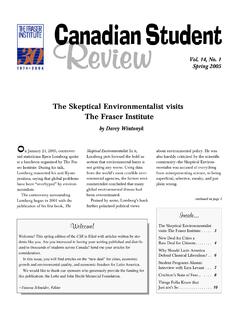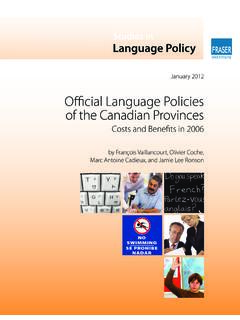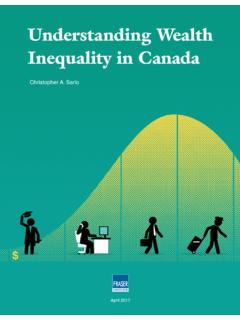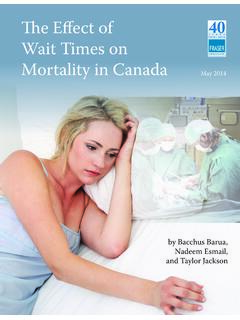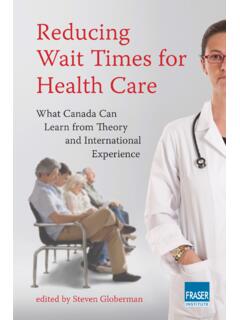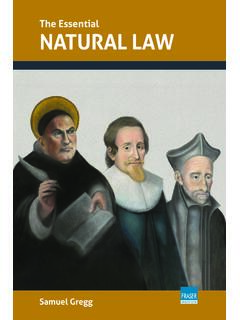Transcription of Report Card on British Columbia’s Secondary Schools 2020
1 FRASERI N S T I T U T Card on British columbia s Secondary Schools 2020 Joel Emes and Peter CowleyReport Card on British columbia s Secondary Schools 2020 By Joel Emes and Peter Cowley2 ContentsIntroduction / 3 Key academic indicators of school performance / 5 Other indicators of school performance / 9 Detailed school reports / 10 How does your school stack up? / 31 Appendix: Calculating the Overall rating out of 10 / 34 About the Authors / 36 Publishing information / 37 Supporting the Fraser Institute / 38 Purpose, funding, & independence / 38 About the Fraser Institute / 39 Editorial Board / 403 The Report Card on British columbia s Secondary Schools collects a variety of relevant, objective indica-tors of school performance into one easily accessible, public document so that all interested parties par-ents, school administrators, teachers, students, and taxpayers can analyze and compare the perfor-mance of individual Schools .
2 Parents use the Report Card s indicator values, ratings, and rankings to com-pare Schools when they choose an education provider for their children. Parents and school administrators use the results to identify areas of academic perfor-mance in which improvement can be Report Card helps parents chooseWhere parents can choose among several Schools for their children, the Report Card provides a valuable tool for making a decision. Because it makes comparisons easy, the Report Card alerts parents to those nearby Schools that appear to have more effective academic programs. Parents can also determine whether Schools of interest are improving over time.
3 By first studying the Report Card, parents will be better prepared to ask relevant questions when they interview the principal and teachers at the Schools under course, the choice of a school should not be made solely on the basis of any one source of infor-mation. Families choosing a school for their students should seek to confirm the Report Card s findings by visiting the school and interviewing teachers and school administrators. Parents who already have a child enrolled at the school can provide another point of view. Useful information may also be found on the web sites of the ministry of education, local school boards, and individual Schools .
4 In addition, a sound academic program should be complemented by effec-tive programs in areas of school activity not measured by the Report Card. Nevertheless, the Report Card provides a detailed picture of each school that is not easily available Report Card facilitates school improvementCertainly, the act of publicly rating and ranking Schools attracts attention; attention can provide motivation. Schools that perform well or show consis-tent improvement are applauded. Poorly performing Schools generate concern, as do those whose per-formance is deteriorating. This inevitable attention provides an incentive for all those connected with a school to focus on student , the Report Card offers more than moti-vation; it also offers opportunity.
5 The Report Card includes a variety of indicators, each of which reports results for an aspect of school performance that might be improved. school administrators who are dedicat-ed to improvement accept the Report Card as another source of opportunities for Schools do better than othersTo improve a school , one must believe that improve-ment is achievable. This Report Card provides evidence about what can be accomplished. It demonstrates clearly that, even when we take into account students characteristics, which some believe dictate the degree of academic success that students will have in school , some Schools do better than others.
6 This finding confirms the results of research carried out in other IntroductionReport Card on British columbia s Secondary Schools Indeed, it will come as no great surprise to experienced parents and educators that the data consistently suggest that what goes on in the Schools makes a difference to academic results and that some Schools make more of a difference than are at the heart of the improvement processComparative and historical data enable parents and school administrators to gauge their school s effective-ness more accurately. By comparing a school s latest results with those of earlier years, they can see if the school is improving.
7 By comparing a school s results with those of neighbouring Schools and of Schools with similar student characteristics, they can identify more successful Schools and learn from them. Reference to overall provincial results places an individual school s level of achievement in a broader is great benefit in identifying Schools that are particularly effective. By studying the techniques used in Schools where students are successful, less effective Schools may find ways to are at the heart of improvement: making comparisons among Schools is made simpler and more meaningful by the Report Card s indicators, ratings, and can contribute to the Report Card s developmentThe Report Card program benefits from the input of interested parties.
8 We welcome your suggestions, comments, and criticisms. Please contact Joel Emes at See, for instance, Michael Rutter et al., Fifteen Thousand Hours: Secondary Schools and Their Effects on Children (Harvard University Press, 1979); Peter Mortimore et al., school Matters: The Junior Years (Open Books, 1988).5 Key academic indicators of school performanceThe foundation of the Report Card is an overall rating of each school s academic performance. Building on data about student results provided by the Ministry of Education,1 we rate each school on a scale from zero to 10. We base our overall rating of each school s academic performance on six indicators:(1) the average exam mark in the grade-12 language arts courses that include a mandatory provincial exam;(2) the percentage of grade-12 language arts mandatory provincial examinations failed;(3) the average difference between the school mark and the examination mark in the courses considered in (1) and (2) above;(4) the average difference between male and female students in their exam mark in the school s most popular grade-12 language arts course;(5) the graduation rate.
9 (6) the delayed advancement have selected this set of indicators because they provide systematic insight into a school s performance. Because they are based on annually generated data, we can assess not only each school s performance in a year but also its improvement or deterioration over indicators of effective teaching1 Average mandatory examination marksThis indicator (in the tables Average exam mark) is the average mark achieved by a school s students on the grade-12 final examinations in language For each school , the indicator is the average of the mean scores achieved by the school s students in each of these mandatory examinations at all sittings during the year, weighted by the relative number of students who wrote the are designed to achieve a distribu-tion of results reflecting the differences in students mastery of the course work.
10 Differences among students in interests, abilities, motivation, and work-habits will inevitably have some impact upon the final results. There are, however, recognizable differences from school to school within a district in the average results on the provincial examinations. Such differ-ences in outcomes cannot be wholly explained by the individual and family characteristics of the school s students. It seems reasonable, therefore, to include the average examination mark for each school as one indicator of effective Percentage of provincial examinations failedFor each school , this indicator (in the tables Percentage of exams failed) provides the rate of failure (as a per-centage) in the grade-12 language arts mandatory provincial examinations.

